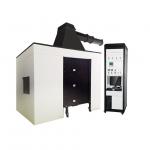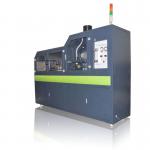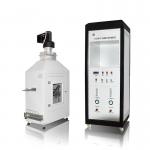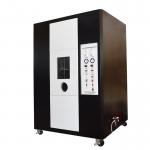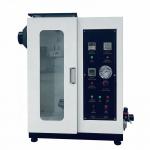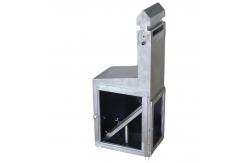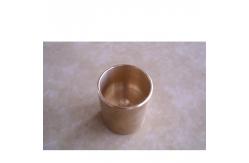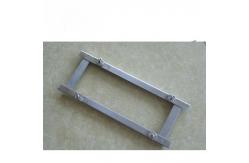In the world of fireproofing and coatings technology, the ASTM
D1360 Fire Retardant Paints Coatings Test Apparatus (Cabinet
Method) emerges as a vital tool. It is specifically designed to
meticulously evaluate the fire-retardant properties of paints and
coatings in a controlled and standardized environment. The ASTM D1360 Fire Retardant Paints Coatings Test Apparatus
(Cabinet Method) is a specialized device used to determine the
effectiveness of fire retardant paints and coatings. It is widely
utilized in research laboratories, paint manufacturing facilities,
and quality control departments. By subjecting painted samples to a
precisely defined fire scenario within a cabinet, it measures
crucial parameters such as flame spread rate, smoke production, and
char formation. These measurements are essential for understanding
the fire protection capabilities of the coatings, ensuring
compliance with safety standards, and guiding the development and
improvement of fire retardant paint formulations. - Robust and Heat-Resistant Cabinet Construction
- The test cabinet is constructed from high-quality heat-resistant
materials, such as stainless steel and refractory alloys. It is
engineered to withstand the intense heat and corrosive gases
generated during the testing process. The interior of the cabinet
is designed to provide a uniform heat distribution, minimizing any
hot spots that could affect the accuracy of the test results. The
cabinet's insulation is carefully selected to maintain a stable
temperature environment and protect the surrounding area from
excessive heat.
- The door of the cabinet is equipped with a reliable sealing
mechanism to prevent the escape of flames and smoke during the
test. It also has a viewing window made of heat-resistant glass,
allowing operators to observe the test progress without
compromising safety.
- Precision Instrumentation and Measurement Capabilities
- The apparatus is equipped with advanced sensors and a sophisticated
data acquisition system. Optical sensors are used to accurately
measure the flame spread rate, tracking the progress of the flame
front across the painted sample. Smoke density sensors monitor the
amount of smoke produced, providing valuable information about the
potential toxicity and visibility impairment in a fire situation.
Temperature sensors are strategically placed to record the
temperature changes within the cabinet and on the sample surface.
- The user interface is intuitive and user-friendly. Operators can
easily set test parameters such as the intensity of the ignition
source, test duration, and sample size. The data acquisition system
records all test data in real-time, including flame spread rate,
smoke density, temperature profiles, and any other relevant
information. It can generate detailed reports, complete with graphs
and charts, that vividly illustrate the performance of the tested
paint or coating. The apparatus also has built-in calibration
functions to ensure the accuracy of the measurements over time.
- Controlled Ignition and Ventilation Systems
- The ignition system of the ASTM D1360 apparatus is highly precise
and adjustable. It can produce a consistent flame of a specific
intensity and duration, replicating real-world fire conditions. The
fuel supply for the ignition source is carefully regulated to
ensure reproducibility of the test.
- The ventilation system of the cabinet is also adjustable. It allows
for the control of air flow within the cabinet, which is crucial as
air movement can significantly affect the combustion behavior of
the paint or coating. By varying the ventilation rate, operators
can simulate different fire scenarios and obtain more comprehensive
data about the performance of the tested material.
- Technical parameters
| Test station | 1 station | | Test board size | L300 x W150 thickness is (5±0.2) mm, the surface is smooth and
glossy. | | Fuel | Chemically pure grade ethanol | | Fuel cup | Brass material, outer diameter 24mm, height 17mm, wall thickness
1mm | | Specimen holder | Tilted 45±3 degrees | | Combustion chamber size | L340 x W250 x H860 (mm) |
- Accurate Evaluation of Fire Retardant Performance
- The primary function of the test apparatus is to provide a detailed
and accurate assessment of the fire retardant properties of paints
and coatings. By precisely measuring the flame spread rate, it
determines how quickly a fire can progress across a surface coated
with the material. A lower flame spread rate indicates a more
effective fire retardant, which is of utmost importance in
applications where fire safety is critical, such as in buildings,
industrial facilities, and transportation.
- The measurement of smoke production and char formation is equally
significant. Smoke can cause respiratory problems and reduce
visibility during a fire, while char formation can act as a
protective layer, insulating the underlying material from further
combustion. Understanding these aspects helps in evaluating the
overall fire protection effectiveness of the coating.
- Compliance with Safety Standards and Regulations
- The paint and coatings industry is subject to a multitude of safety
standards and regulations. The ASTM D1360 Fire Retardant Paints
Coatings Test Apparatus (Cabinet Method) is a reliable tool for
ensuring compliance. It enables manufacturers to conduct tests in
accordance with the ASTM D1360 standard, which is widely recognized
and used in the industry. By using this apparatus, manufacturers
can prove that their products meet the necessary safety benchmarks,
facilitating market access and enhancing consumer confidence.
- Regulatory bodies rely on the accurate test results obtained from
this equipment to enforce safety regulations. It serves as a
dependable means for inspectors and certifying agencies to
determine the suitability of fire retardant paints and coatings for
use in different applications and environments.
- Research and Development Support
- In the field of paint and coatings research and development, the
test apparatus is an invaluable asset. It allows chemists and
engineers to study the fire behavior of new formulations. For
example, in the development of environmentally friendly fire
retardant coatings or those with enhanced durability and fire
resistance, the apparatus can be used to evaluate the impact of
different additives, binders, and pigments.
- By understanding how different factors influence the fire retardant
properties, researchers can optimize the design and composition of
coatings. This could involve the addition of novel flame retardant
agents, the modification of the coating's microstructure, or the
development of new application techniques. The detailed data
provided by the test apparatus serves as a roadmap for driving
innovation and improving the fire safety of painted surfaces.
- Stringent Manufacturing Process
- The ASTM D1360 Fire Retardant Paints Coatings Test Apparatus
(Cabinet Method) is manufactured under strict quality control
procedures. Each component is carefully sourced and inspected for
quality and performance. The assembly process is carried out by
highly trained technicians in a clean and controlled environment,
ensuring the proper alignment and functionality of all parts.
- The calibration of the ignition system, sensors, and measurement
systems is a critical and regular part of the manufacturing
process. It is performed using traceable reference standards to
guarantee the accuracy and reproducibility of the test results.
Rigorous quality audits and inspections are conducted at various
stages of production to maintain the highest level of product
quality.
- Quality Certification and Validation
Our test apparatus has obtained relevant quality certifications and
has been validated by independent testing laboratories. It has been
proven to provide accurate and reliable test results, conforming to
the ASTM D1360 standard and other relevant international and
national safety standards. We also continuously update and improve
our product based on the latest technological advancements and
customer feedback to ensure its long-term performance and
compliance.
- Paint Manufacturing Industry
- A leading fire retardant paint manufacturer used the ASTM D1360
apparatus to develop a new line of high-performance coatings. The
test results showed that the new formulations had significantly
lower flame spread rates and reduced smoke production compared to
their previous products. This enabled them to market the paint as a
top choice for fire protection in commercial and residential
buildings. The company experienced an increase in sales and
enhanced its reputation for producing quality fire retardant
coatings.
- A paint research and development center utilized the apparatus to
study the fire behavior of different pigment combinations in fire
retardant paints. By testing various pigments and their
concentrations, they were able to optimize the paint's color
options while maintaining excellent fire resistance. The resulting
paints were well-received by architects and designers who were
looking for both aesthetic and fire-safe coating solutions.
- Construction and Building Materials Sector
- A building materials company used the test results from the
equipment to select appropriate fire retardant paints for their
wood-based products. By choosing paints with low flame spread rates
and minimal smoke production, they were able to enhance the fire
safety of their wooden doors, window frames, and paneling. This led
to increased compliance with building codes and a competitive edge
in the market.
- An architectural firm incorporated the data from the ASTM D1360
apparatus into their building design process. They were able to
accurately predict the fire behavior of painted surfaces and design
more effective fire protection strategies. For example, they
specified the use of particular fire retardant paints in critical
areas such as corridors, stairwells, and elevator shafts, improving
the overall fire safety of the building.
- Automotive and Transportation Industries
- An automotive parts manufacturer used the ASTM D1360 Fire Retardant
Paints Coatings Test Apparatus (Cabinet Method) to test the fire
resistance of coatings used on vehicle interiors. The data helped
them select paints that met strict safety standards and provided
enhanced protection in case of a vehicle fire. This contributed to
improved consumer safety and compliance with automotive safety
regulations.
- A transportation equipment manufacturer utilized the apparatus to
develop fire retardant paints for shipping containers and cargo
holds. The accurate test results allowed them to create coatings
that minimized the risk of fire spread during transportation,
protecting valuable goods and ensuring the safety of the crew and
the environment.
- Pre-Sales Technical Consultation
Our team of experts provides in-depth technical consultations to
help customers understand the capabilities and suitability of the
ASTM D1360 Fire Retardant Paints Coatings Test Apparatus (Cabinet
Method) for their specific testing needs. We offer demonstrations
and training to familiarize customers with the operation and
functionality of the equipment before purchase. We also assist in
selecting the appropriate test methods and accessories based on the
paint formulations and applications to be tested. - After-Sales Service and Maintenance
We offer comprehensive after-sales service, including on-site
installation and commissioning. Our technicians are available for
regular maintenance, calibration, and emergency repairs. We provide
spare parts and upgrades to keep the apparatus operating at peak
performance. We also offer service contracts that include
preventive maintenance and priority technical support, ensuring the
long-term reliability and availability of the equipment. - Training and Technical Support
We conduct training programs for new users to ensure they can
effectively operate the ASTM D1360 Fire Retardant Paints Coatings
Test Apparatus (Cabinet Method) and interpret the test results. Our
technical support team is available 24/7 to answer questions,
provide troubleshooting assistance, and offer guidance on test
method optimization and compliance with relevant standards. We also
provide software updates and support for the data acquisition and
analysis systems, enabling customers to take full advantage of the
latest features and technologies.
The ASTM D1360 Fire Retardant Paints Coatings Test Apparatus
(Cabinet Method) is an essential tool for ensuring the fire safety
of painted surfaces. With its advanced features, accurate
measurements, and reliable performance, it empowers the paint and
coatings industry to make informed decisions, develop safer
products, and comply with safety regulations. Invest in our test
apparatus and take a significant step towards enhancing fire
protection and innovation in the field of fire retardant paints and
coatings. |
